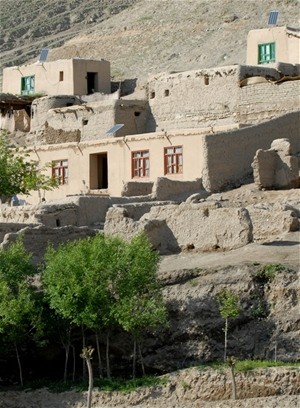
The construction of the Kishim-Fayzabad Road has brought prosperity – and electricity – to the village of Gunbaz Balocha. Solar panels now dot the rooftops of many homes.
Lizette Potgieter
Solar panels now dot the rooftops of many homes.
13 OCTOBER 2009 | GUNBAZ BALOCHA, BADAKHSHAN, AFGHANISTAN
Gunbaz Balocha village is located in remote Badakhshan province along the Kishim-Fayzabad Road. USAID is currently reconstructing the entire 103-km road, along with its bridges and drainage structures. Roads such as Kishim-Fayzabad provide many social and economic benefits to residents – and road construction brings jobs and prosperity to communities like Gunbaz Balocha.
Over the years, frequent floods and mudslides had reduced the Kishim-Fayzabad Road to a primitive dirt track with poorly maintained drainage structures. The poor road conditions put a damper on trade in the area and consequently on local prosperity.
As construction continues, signs of new prosperity, such as solar panels, are springing up along the road. Residents of Gunbaz Balocha and other villages are renovating or building homes, and larger buildings are under construction in Kishim and Fayzabad. Entrepreneurs are starting new businesses, and older establishments are being renovated in hopes that the road will bring more customers.
The road itself, and the construction jobs it provides to many residents of the area, is the main reason for the local economic boost. The project employs more than 1,000 Afghan workers, whose average daily wage is around $10 – a good day’s pay in Afghanistan. That amounts to more than $10,000 per day that the project injects into the local economy.
The road work is not easy. The project involves a huge amount of excavation, including 1.5 million cubic meters of rock. Much of the rock is being used to construct culverts, retaining walls, ditches, and other drainage structures to protect the road and villages. This work provides steady employment to local stonemasons. Besides being able to support their families, many have saved enough money to improve their quality of life – such as buying solar panels for their roofs.







Comment
Make a general inquiry or suggest an improvement.